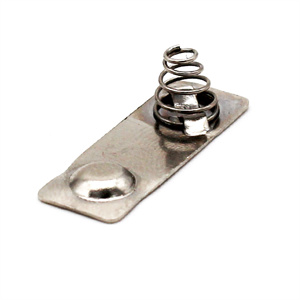Battery contact also known as contact shrapnel, battery spring contact, etc., is an important part of the battery, which is used to connect the positive and negative poles of the battery. According to different classification standards, battery shrapnel can be divided into different types.
According to different materials, battery contact shrapnes can be divided into copper, iron, stainless steel and other types. Battery shrapnel of different materials has different electrical conductivity and corrosion resistance, so it is suitable for different types of batteries.
According to the different shapes, battery contact can be divided into two types: straight and bent. Straight tabs are usually used for prismatic cells, while bent tabs are usually used for round cells.
According to different uses, battery contact / shrapnel can be divided into two types: single-sided shrapnel and double-sided shrapnel. Single-sided shrapnel is usually used for the connection of the positive or negative electrode, while double-sided shrapnel is usually used for the connection between the positive and negative electrodes.
In short, different types of battery shrapnel have different characteristics and application scenarios, and choosing the right shrapnel is very important to ensure the normal use and safety of the battery.
The Ground Battery Spring Contact offers the following features and advantages:
Reliable grounding connection: stable and low resistance connection can be established between the battery and the grounding system, which can effectively lead the charge to the ground and guarantee the safety of equipment and users.
Elastic buffering effect: the spring is designed to absorb vibration and impact during the installation and use of the battery, so as to prevent loose or damaged connection caused by mechanical stress.
Good conductivity: It is usually made of high conductivity materials, such as copper or silvered copper, to ensure smooth transmission of grounding current and reduce resistance and heating.
Suitable for different sizes and shapes: with certain elastic deformation capacity, it can adapt to batteries of different specifications and models and provide universal grounding solutions.
In practical application:
For example, in the backup battery pack of the communication base station, the grounding spring contact can guarantee the safe grounding of the battery under the complex electromagnetic environment.
In the power supply part of industrial control system, it can effectively prevent electrostatic accumulation and electromagnetic interference.
However, battery ground spring contacts have some limitations:
Fatigue life: Long-term compression and extension may lead to fatigue of the spring, reducing its elastic property and contact reliability.
Installation space requirements: due to the structure of spring, certain installation space may be required, which may pose challenges for equipment with compact space
